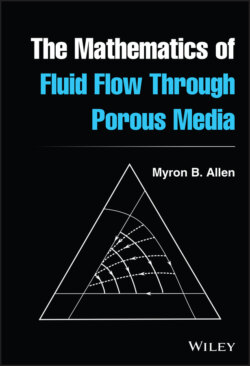Читать книгу The Mathematics of Fluid Flow Through Porous Media - Myron B. Allen III - Страница 31
2.5.2 Densities and Volume Fractions
ОглавлениеAs with single continua, we assign to each constituent a mass density such that the mass of the constituent in any measurable region of three‐dimensional space at time is
Engineers call the bulk density of constituent ; it gives the mass of the constituent per unit of total volume in the continuum.
In the context of porous media, this last observation prompts a discussion of two different categories of multiconstituent continua. The first, which we call multiphase continua or immiscible continua, includes materials for which microscopic observation reveals continuum‐scale interfaces that affect the mechanics. Figure 2.12 illustrates the idea schematically. An example of this type of continuum is water‐saturated sandstone. In this porous medium, there exists a continuum‐scale interface between the rock and the fluid, but in most sandstones, the geometry of the interface is observable only at scales smaller than about m.
One way to think of this type of continuum is to regard macroscopic observation as a spatial averaging process. In this view, at each point in space we replace detailed properties of the material with properties averaged over a representative elementary volume (REV) having a characteristic radius, as Figure 2.12 illustrates [121]. In the case of water‐saturated sandstone, if the radius of the REV ranges over values comparable to typical rock‐grain diameters, then the fraction of the REV occupied by fluid oscillates as the radius increases. The oscillation arises because, over this range of radii, the inclusion or exclusion of individual grains results in significant changes in the value of the average.
Figure 2.12 Sketch of a fluid‐saturated porous medium showing three possible representative elementary volumes.
For the concept of a multiconstituent continuum to furnish a useful model of the porous medium, there must exist a range of REV radii—typically exceeding several rock‐grain diameters—in which the fraction of the REV occupied by fluid exhibits a stable value, as drawn in Figure 2.13. Henceforth, we assume that the porous medium possesses a range of REV radii satisfying this condition. We also assume that this range includes radii that are small compared with the macroscopic scale of observation, so that it is reasonable to model the porous medium as a set of overlapping continua.
Under this assumption, we assign to each constituent a volume fraction . This function gives the fraction of any region of three‐dimensional space occupied by material from the constituent as
Figure 2.13 Conceptual plot of REV‐averaged volume fraction versus radius of averaging window, showing how averaged values can stabilize for a range of averaging radii.
If we account for all of the volume in the continuum, then the volume fractions obey the constraint
In this case, we define the true density of constituent as
The bulk density has dimension (mass of )(volume of continuum), while the true density has dimension (mass of )(volume of ).
In the second category of multiconstituent continua, segregation of constituents is observable only at molecular length scales, so continuum‐scale interfaces between the constituents do not exist. Saltwater is an example: The particles of , , and O are segregated at length scales of roughly m, far smaller than the continuum scale. For such multispecies or miscible multiconstituent continua, the concept of a continuum‐scale volume fraction does not apply.
With this framework in place, we define several functions associated with the continuum. The mixture density is
which we can write for multiphase continua as follows:
The mass‐weighted or barycentric velocity is
Sometimes it is useful to refer to the barycentric derivative, which for a differentiable function has the form
(2.26)
Finally, the diffusion velocity of constituent is
(2.27)
Exercise 2.14 Show that
